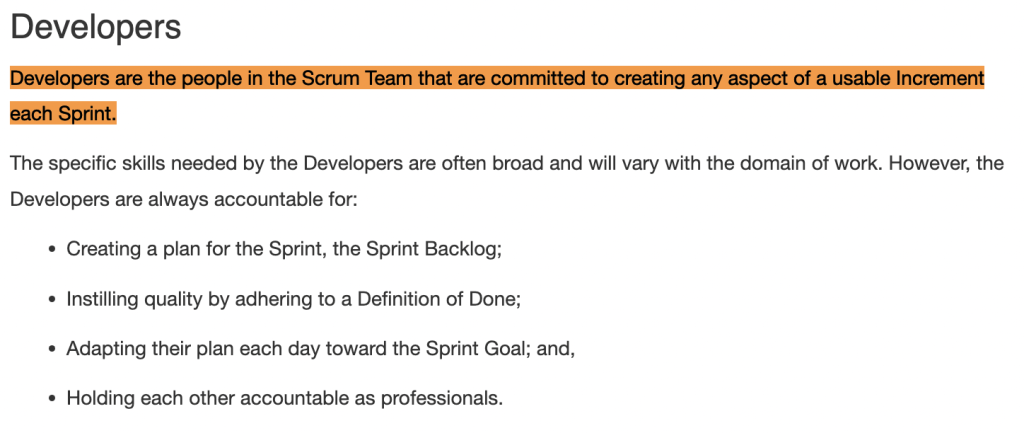Which Scrum Role is responsible to do all the work required to turn Product Backlog in potentially releasable items?
A. The Business Analyst
B. The Stakeholders
C. The Development Team
D. The Project Manager

Quick Summary
Which Scrum Role is responsible to do all the work required to turn Product Backlog in potentially releasable items?
A. The Business Analyst
B. The Stakeholders
C. The Development Team ✅
D. The Project Manager
Correct Answer: C
Explanation: There are no Project Managers and Business Analysts in Scrum. Stakeholders only provide the requirements for the Product Backlog items but will not support the development (directly)
The Development Team’s Role in Scum (Option C)
In Scrum, the Development Team is responsible for doing all the work required to turn Product Backlog items into potentially releasable increments of the product. The Development Team is a self-organizing and cross-functional group of professionals who have the skills and expertise to deliver a potentially shippable product increment at the end of each Sprint. The team works together collaboratively and is responsible for tasks such as analysis, design, implementation, testing, and documentation. The other options (A. The Business Analyst, B. The Stakeholders, D. The Project Manager) do not have the primary responsibility for the actual development work in the Scrum framework.
Developers are the people in the Scrum Team that are committed to creating any aspect of a usable Increment each Sprint.
From the Scum Guide
- The Development Team in Scrum is a self-organizing and cross-functional group of individuals who have the skills and expertise to turn Product Backlog items into a potentially releasable product increment.
- The team is responsible for all aspects of product development, including but not limited to analysis, design, implementation, testing, and documentation.
- They collaborate closely with the Product Owner to understand the requirements and with the Scrum Master to continuously improve their processes.
- The Development Team is empowered to make decisions on how to achieve the goals set by the Product Owner and is accountable for delivering high-quality increments at the end of each Sprint.
Now let’s look at the Scrum Guide taking some quotes relevant to developers.

In summary, the Development Team is a crucial component of the Scrum framework, responsible for turning the Product Backlog into valuable and potentially shippable increments of the product. Their autonomy and self-organization are key principles in Scrum
The Other Roles in Scum
A. The Business Analyst:
- While the Scrum Guide doesn’t explicitly mention the role of a Business Analyst, in some organizations, a Business Analyst may still play a supportive role.
- Their involvement might be more prominent during Sprint Planning, helping to refine and elaborate on Product Backlog items.
B. The Stakeholders:
- Stakeholders are individuals or groups with an interest in the product. They may include customers, users, managers, and others.
- Stakeholders are involved throughout the Scrum process. They provide input during Sprint Reviews, offering feedback on the product increment. Their feedback can influence the priorities in the Product Backlog.
D. The Project Manager:
- In traditional project management, the Project Manager has a central role in planning, executing, and closing projects. In Scrum, the role of a Project Manager is less defined.
- Scrum emphasizes a self-organizing Development Team and often does not have a traditional Project Manager role. Scrum Masters serve as facilitators, and teams are encouraged to self-manage.
While these roles may exist in an organization using Scrum, it’s crucial to understand that Scrum distributes responsibilities in a way that fosters collaboration and empowers the Development Team to make decisions about how to achieve the goals set by the Product Owner. The Scrum Master supports the Scrum Team and helps remove impediments, while the Product Owner prioritizes the work based on business value. The Development Team is responsible for delivering a potentially shippable product increment.
References:
Scrum Guide, 2021
